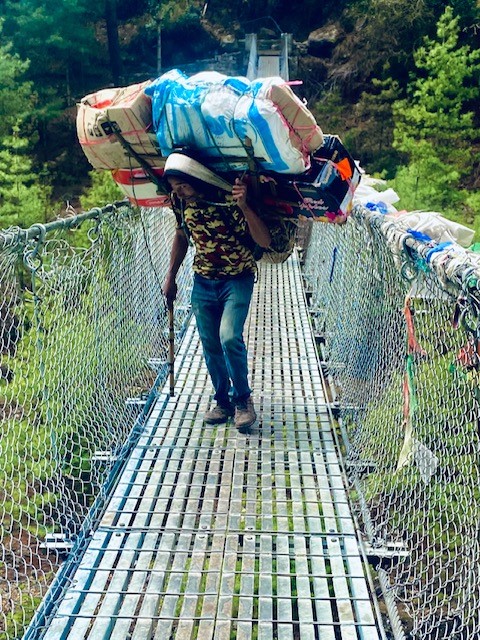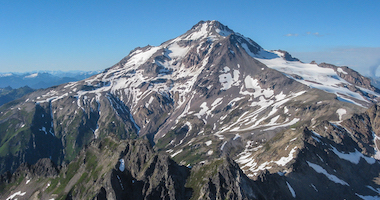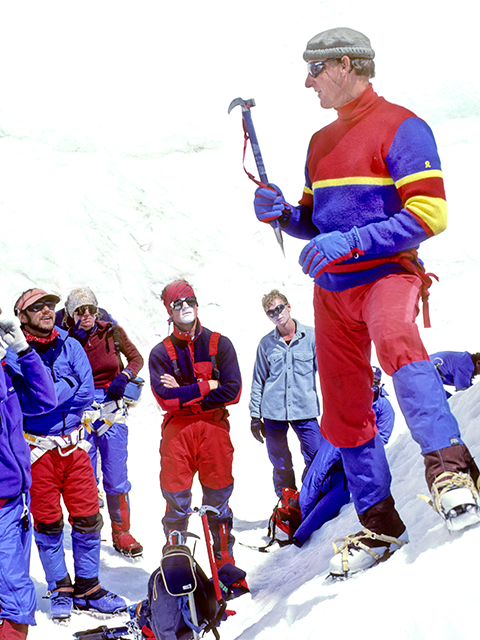Most Popular Entries
Posted by: Adam Knoff
Categories: Expedition Dispatches Everest BC Trek and Lobuche
Elevation: 13,950'



Namaste from the small village of Pheriche.
I know this might come as a surprise to many of you, but we woke up at the same time as the last 5, ate the same food and packed our bags for another meditative day of trekking. The departure was a bit more emotional than the previous mornings because I had to say farewell to the host family I so thoroughly enjoyed seeing after so many years but as we all know, time continues to roll, and we will one day see each other again.
Easing the sadness of leaving Phortse was the crystal blue skies and breathtaking views of the mountains we have been waiting to see. Within 30 minutes of leaving the Phortse Guest House, we were greeted with stunning vistas of three major peaks, one being Ama Dablam, arguably the most iconic peak in all of Nepal. Later in the day Mt. Everest even made a quick showing. Energized from such a powerful landscape we cruised the three hours to Pangboche which is the oldest Sherpa village in the entire region. It is also the location of a very old Monastery where we were lucky enough to arrange a Puja ceremony with the head Lama of the village. This ceremony is a special blessing granting us passage into the mountains with luck and safety. Shortly after the Puja we had a good lunch giving us strength to polish off the remaining distance to camp.
Making better time on the second half of the trail, we could focus on the walk and not take a thousand pictures because the clouds moved in and shut down the views. We rolled into our tea house just in time to have the fire warming the great room and hot tea ready. We were also very happy to see the other RMI group and share stories of the adventures already had and the ones to come. Casey Grom is one of my closest friends, so I feel lucky to have gone from one emotional encounter to the next. Although the visits are brief, they are meaningful, nonetheless.
Now the team is all tucked in and I myself am off to bed, happy to have a rest day tomorrow. Everyone is in good spirits and doing well.
We will reconvene tomorrow at the same time.
RMI Guide Adam Knoff and Team
Posted by: Bryan Mazaika, Josh Geiser, Joey Manship
Categories: Expedition Dispatches Mount Rainier
Elevation: 14,410'
The Four Day Climb Led by RMI Guide Bryan Mazaika reached the summit of Mt. Rainier early this morning. The team had clear skies above Camp Muir and a good climbing route. The team is on the descent and will be celebrating at Rainier Basecamp this afternoon.
Congratulations team!
Posted by: Christina Dale, Joe Hoch, Dustin Wittmier, Dominic Cifelli, Erika Birkeland, Seth Burns
Categories: Expedition Dispatches Mount Rainier
Elevation: 14,410'



The Four Day Climb May 28 - 31th led by RMI Guides Christina Dale and Joe Hoch led their teams to the summit of Mt. Rainier this morning. It's a beautiful day on the mountain and Joe reported the route was in good shape and would likely be improving with the warm temperatures and stable weather expected. The teams enjoyed about an hour in the crater and began their descent from the crater rim just before 8 am today. The team will return to Camp Muir and then continue down to Paradise later this afternoon.
Congratulations to today's climbers!
Posted by: Casey Grom
Categories: Expedition Dispatches Kilimanjaro



Hello again everyone,
Today we visited the famous Ngorongoro Crater, one of the 7 natural wonders of the world. The crater is roughly 100 square miles and is home to more than 25,000 animals that reside here year round, as its one of the few places that has natural springs. We started early with hopes of catching a few big cats before the heat of the day sent them in search of shade.
We saw many hyenas, jackles, ostrich, plus countless other huge birds, and even managed to get close to a large pride of lions with very full bellies. There was a Black Rhino spotted not to far off of the road also which was a highlight.
We wrapped up the day with a visit to a Maasai village not far from the crater's rim. The Maasai people are a semi-nomadic tribe that exist almost entirely off of their cattle. The team spent time asking questions and enjoyed being shown around their small and simple village.
We have just finished another wonderful meal here at the plantation lodge and the team is off to bed after a long, but very rewarding day on safari.
RMI Guide Casey Grom and the safari crew

Posted by: Alex Halliday, Dominic Cifelli, Chase Halbert
Categories: Expedition Dispatches North Cascades
Elevation: 9,131'

We had a short day getting to our camp at Lake Ann on Tuesday. The Fisher Chimneys were too wet for us to ascend any higher. So we woke up early to make our attempt at the summit. Starting in the dark and ending in the dark meant we had a very long and very hard but successful summit day yesterday. Today we will descend to the trail head and complete our program.
Thanks for joining us!
- RMI Guide Alex Halliday
Posted by: Walter Hailes, Camille Leininger, Augi Fleer, Dominic Cifelli, Leif Bergstrom, Liam Weed
Categories: Expedition Dispatches Mount Rainier
Elevation: 10,080'
The Four Day Climb June 8 - 11 led by RMI Guides Walter Hailes and Dominic Cifelli were unable to make their summit attempt this morning. Strong winds and blowing snow made for unsafe climbing conditions and kept the team hunkered down at Camp Muir over night. The telemetry from Camp Muir shows wind averages ranging from mid 20 to mid 60 mph over night with gusts up to 79 mph. When the group radioed the office this morning they were experiencing estimated 50 mph winds. The team will be descending from Camp Muir today and return to Rainier BaseCamp. Unfortunately, today was not their day to reach the summit of Mt. Rainier.
Next time boys!
Posted by: Brandon Sprout on 6/11/2021 at 9:54 pm
On The Map
Hi Mark, we are glad to see you with your team. We hope you will continue to have a good trip and we will follow your adventure via this blog!!
Posted by: Wally Rappe on 2/13/2013 at 5:58 pm
Looks like you are doing well and should I say, even “rested”. hope you are keeping a log so we can hear all about the climb. Push your limits!!! jL
Posted by: John Lind SR on 2/13/2013 at 4:18 pm
Posted by: Adam Knoff
Categories: Expedition Dispatches Everest BC Trek and Lobuche
Elevation: 11,300'



Today proved to be a much less stressful day than yesterday. Waking up to five thousand vertical feet of relief directly out your window, fabulous crisp Himalayan air and the absence of a bajillion people trying to run you over is pure bliss. Combine that with French press coffee, pancakes, eggs and homemade chapati bread and the day is off to a good start.
After breakfast we got our porters loaded up to carry our unneeded gear ahead to our next lodge then hit the trail for our first miles towards Everest Base Camp. What is so unique about this area is this trail is not only a trail but an interstate, superhighway, autobahn, or backwoods country road; it is the single line on which literally everything in this area gets moved through. If you want a beer, it came up on a human’s back. If you want French fries, noodles, toilet paper, clothing, or anything else under the Himalayan sun, it was moved by legs of some kind. No automobiles have ever driven this path, nor will they. It is the way things used to be.
After three delightful hours of walking, we stopped at a small tea house for lunch then polished off the remaining 2 miles to Namche Bazaar, capitol of the Khumbu Region. This last two miles gained us more elevation than the previous four so by the time we rolled into or lodge we were ready for a rest. Despite being over 11,000 feet, the team is feeling good and looking forward to an even more mellow day tomorrow. We are enjoying decent weather in the morning and light rain by the afternoon. A great combo for walking then drinking tea and beer.
Stay tuned for our rest day adventure tale.




Yesterday all members of the RMI Mexico team arrived safely in Mexico City. With a quick team meeting to cap off the night, we were off to bed to sleep off the long day of travel.
La Malinche is the first objective of the trip, an acclimatization hike that takes us up to 14,501 ft. We couldn’t have picked a better day for it. Warm, nearly windless weather greeted us at the base and followed us all the way to the summit of the peak. For many of us it was our high point! We spent a good 30 minutes up high taking in the views, petting the dogs that would mosey our way, and eating our favorite snacks (maybe that’s why the dogs came over). Before long it was time to head down, we had carne asada to get to. A safe and uneventful descent followed, just the way we like it, and the team enjoyed some relaxation before our delicious dinner. Now it’s time to rest up for the next leg of the journey. We head to Ixta Basecamp tomorrow!
Posted by: JT Schmitt, Christina Dale, Jess Wedel, Tyler Meyers, Jenna Burkey, Roland Scott
Categories: Expedition Dispatches Mount Rainier
Elevation: 14,410'
The Four Day Climb June 27 - 30 reached the summit of Mt. Rainier this morning led by RMI Guides JT Schmitt and Christina Dale. Christina reported great route conditions and clear skies. The teams were on their descent at Camp Comfort around 7:30 am making their way back to Camp Muir. The teams will continue their descent to Paradise and then be transferred to Rainier BaseCamp.
Congratulations to today's climbers!
Congratulations everyone! You must be so proud of yourself! We can’t wait to have to full story of your adventure! ❤️
Posted by: My-Lien on 6/30/2022 at 12:58 pm
Congratulations, you did it!!!!
Posted by: Carole on 6/30/2022 at 9:08 am























Yeahhhhh Aunt Sam and Matt!!!! We are cheering you on the whole way, and can’t wait to hear your summit story!! Baggin’ peaks and being awesome. ❤️❤️❤️
Posted by: Ellis Bond on 5/31/2021 at 2:54 pm
View All Comments